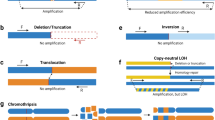Abstract
Pepsinogens (PGA) are the inactive precursors of pepsin, the major acid protease found in the stomach. Highly polymorphic variation of these proteins has been demonstrated in several populations, and comparison of the DNA restriction fragment patterns obtained from informative pepsinogen phenotypes suggest that the polymorphism results from chromosomal haplotypes containing variable numbers of pepsinogen genes. In order to isolate the three most common PGA haplotypes (A, B, and C) and to unambiguously demonstrate their relationship to the observed protein heterogeneity, we constructed mouse × human somatic cell hybrids from individuals heterozygous for PGA and INS (insulin). Here, we describe analysis of hybrid cell lines that segregated human chromosomes containing the PGAgenes and thereby provided for the parasexual discrimination of the different haplotypes on chromosome 11 determining the corresponding heterozygous phenotypes. These studies demonstrate that the A, B, and C haplotypes contain three, two, and one PGAgenes, respectively. This unusual polymorphism of genomic DNA encoding very similar proteins probably reflects recent evolution by gene duplication.
Similar content being viewed by others
Literature cited
Taggart, R.T., Karn, R.C., Merritt, A.D., Yu, P.L., and Conneally, P.M. (1978).Hum. Genet. 52:227–238.
Korsnes, L., and Gedde-Dahl, T. (1980).Ann. Hum. Genet. 43:199–212.
Frants, R.R., Pronk, J.C., Pals, G., et al. (1984).Hum. Genet. 65:385–390.
Samloff, I.M., and Townes, P.L. (1970).Science 168:144–145.
Samloff, I.M., Liebman, W.M., Glober, G.A., Moore, J.O., and Indra, D. (1973).Am. J. Hum. Genet. 25:178–180.
Taggart, R.T., Mohandas, T.K., Shows, T.B., and Bell, G.I. (1985).Proc. Natl. Acad. Sci. U.S.A. 82:6240–6244.
Nakai, H., Byers, M.G., Shows, T.B., and Taggart, R.T. (1987).Cytogenet. Cell Genet. (in press).
Taggart, R.T., Samloff, I.M., Raffel, L.J., Graham, A., et al. (1986).Am. J. Hum. Genet. 38:848–854.
Littlefield, J. (1964).Science 145:709–710.
Creagan, R.P., and Ruddle, F.H. (1977). InChromosomes in Biology and Medicine, J.J. Yunis, (ed.). (Academic Press, New York), pp. 89–142.
Baker, R.M., Brunette, D.M., Mankovitz, R., et al. (1974).Cell 1:9–21.
Kucherlapati, R.S., Baker, R.M., and Ruddle, F.H. (1975).Cytogenet. Cell Genet. 14:192–193.
Ruddle, F.H. (1973).Nature 242:165–169.
Handmaker, S.D. (1973).Annu. Rev. Microbiol. 27:189–204.
Wang, H.S., Niewczas, V., Nazareth, H.R.S., and Hamerton, J.L. (1979).Cytogenet. Cell Genet. 24:233–244.
Sogowa, K., Fujii-Kuriyama, Y., Mizukami, Y., Ichihara, Y., and Takahashi, K. (1983).J. Biol. Chem. 258:5306–5311.
Hayano, T., Sogowa, K., Ichihara, Y., Fujii-Kuriyama, Y., and Takahashi, K. (1986).Biochem. Biophys. Res. Commun. 138:289–296.
Taggart, R.T. & Samloff, I.M..Gastroenterology 92:143–150 (1987).
White, R., Woodward, S., Leppert, M., O'Connell, P., Hoff, M., et al. (1985).Nature 18:382–384.
Knowlton, R.G., Cohen-Hguenauer, O., Van Cong, N., et al. (1985).Nature 318:380–382.
Gusella, J.F., Tanzi, R.E., Anderson, M.A., Hobbs, W., et al. (1984).Nature 225:1320–1326.
Gusella, J.F. (1986).J. Clin. Invest. 77:1723–1726.
de Martinville, B., Kunkel, L.M., Bruns, G., Morlé, F., et al. (1985).Am. J. Hum. Genet. 37:235–249.
Baehner, R.L., Kunkel, L.M., Monaco, A.P., et al. (1986).Proc. Natl. Acad. Sci. U.S.A. 83:3398–3401.
Monaco, A.P., Bertelson, C.J., Middlesworth, W., et al. (1985).Nature 316:842–845.
Kunkel, L.M., Monaco, A.P., Middleworth, W., Ochs, H.D., and Latt, S.A. (1985).Proc. Natl. Acad. Sci. U.S.A. 82:4778–4482.
Nathans, J., Piantanida, T.P., Eddy, R.L., Shows, T.B., and Hogness, D.S. (1986).Science 232:203–210.
Nathans, J., Thomas, D., and Hogness, D.S. (1986).Science 232:193–202.
Author information
Authors and Affiliations
Rights and permissions
About this article
Cite this article
Taggart, R.T., Mohandas, T.K. & Bell, G.I. Parasexual analysis of human pepsinogen molecular heterogeneity. Somat Cell Mol Genet 13, 167–172 (1987). https://doi.org/10.1007/BF01534696
Received:
Revised:
Issue Date:
DOI: https://doi.org/10.1007/BF01534696




